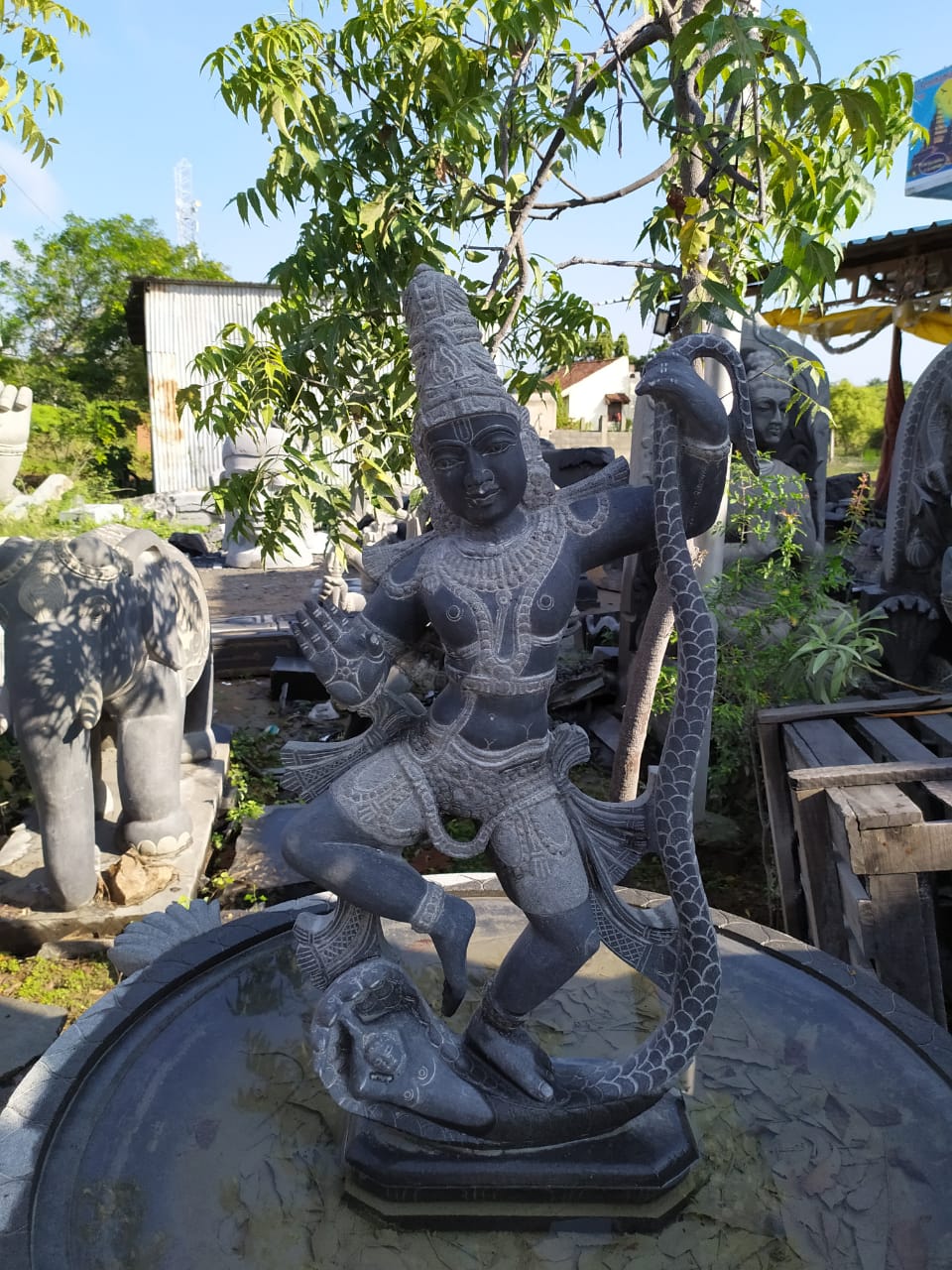Come explore our exquisite Shiva deity sculpture, the cosmic dancer who embodies the never-ending cycle of time. Adorned with a flaming halo and holding the symbols of creation and destruction, this hand carved Shiva sculpture represents the perfect balance between the birth & death. Bring home a piece of ancient mythology and add a touch of old world sophistication to your decor.

The lower right hand is in abhaya ~ protection mudra. The small figure being trampled by the right foot represents apasmara purusha or the ego. Shiva's front left hand is pointed to his left foot, absolving the sins. Dance in itself is similar to meditation where in it induces a trance and is a system of devotion to the energies of universe, Shiva is Natraja the lord of dance and he helps us disconnect the cords of negativity to reach a higher plateau of divine understanding .

Shiva, one of the principal deities in Hinduism, is often portrayed as an ascetic or yogi. His ascetic lifestyle is a significant aspect of his character, symbolizing the detachment from worldly pleasures and the pursuit of spiritual knowledge and realization.Shiva with ash smeared on his body. This ash symbolizes the transient nature of material existence, representing the ultimate reality beyond physical form. Shiva is shown with long, matted hair. The flowing hair symbolizes the uncontrolled, wild forces of nature, and it is believed that Shiva's hair holds the river Ganges, which descended from the heavens, symbolizing the union of the spiritual and the material.Shiva is shown wearing a tiger or deer skin, emphasizing his renunciation of worldly comforts and his connection with the animal kingdom.Shiva with a third eye on his forehead, symbolizing his transcendent vision and insight into the spiritual realms.The trident is a symbol of Shiva's control over the three gunas (qualities) of nature—sattva (goodness), rajas (passion), and tamas (ignorance).Shiva is often shown with a snake around his neck, representing his mastery over fear and death.
Shiva's ascetic lifestyle is a source of inspiration for many devotees who seek to emulate his qualities of detachment, discipline, and spiritual insight. The symbolism associated with Shiva's ascetic form serves as a reminder of the transient nature of the material world and the importance of focusing on spiritual growth and realization

Experience the captivating energy of the divine Shiva with the shiva lingam. Named after his many divine attributes, this powerful piece embodies the tranquil energies of life, the Shiva & Shakti, while grounding you to Mother Earth. Get in touch with your inner power and knowledge with Shiva, the Giver of Joy, the Abode of Joy, and the source of understanding and action.

Shiva is Mahakala, it means not only the God of Death but also the God of Time. Before anything could come to exist, time has to be present. Shiva releases the being from death, and leads the soul to immortality and enlightenment. Shiva is the dissolving force in life. Shiva dissolves in order to create, since death is the medium for rebirth into a new life. So the opposites of life and death and creation and destruction both reside in his character. the dancing form of Lord Shiva means the King of Dancers and symbolizes a marvelously unified and dynamic creation involving the cosmos ,expressing the rhythm and harmony of life.

Unleash your inner dancer with Shiva, the creator of the first rhythmic syllables and the cosmic cycles of creation and destruction. The Ananda Tandava, or Dance of Bliss, symbolizes the daily rhythm of birth and death. Experience the power of eternal energy in this intricate and meaningful sculpture.

The dance of Shiva, also known as the Tandava, is a divine dance that symbolizes the cosmic cycles of creation, preservation, destruction, illusion, and grace. Each aspect of Shiva's dance represents one of his five activities, as you mentioned:
-
Shrishti (Creation, Evolution): This is the aspect where Shiva's dance signifies the creation and evolution of the universe.
-
Sthiti (Preservation, Support): In this aspect, Shiva's dance represents the preservation and support of the universe, maintaining the cosmic order.
-
Samhara (Destruction, Evolution): Shiva's dance in the form of Rudra Tandava signifies the destructive and evolutionary forces that bring about the end of cycles and pave the way for new beginnings.
-
Tirobhava (Illusion): This aspect of Shiva's dance represents the illusionary nature of the world, emphasizing the impermanence and transient nature of reality.
-
Anugraha (Grace): The dance also reflects the aspect of divine grace, where Shiva bestows blessings and benevolence upon his devotees.
The image of Shiva as Nataraja, the Lord of Dance, is a popular representation in Hindu iconography. The dance studio or exercise room is considered an apt place for the image of Nataraja because it symbolizes the harmonious balance of physical and spiritual aspects. The rhythmic movements in dance and exercise echo the cosmic rhythm embodied in Shiva's dance, connecting the practitioner to the divine energy of creation and preservation


Comments (0)